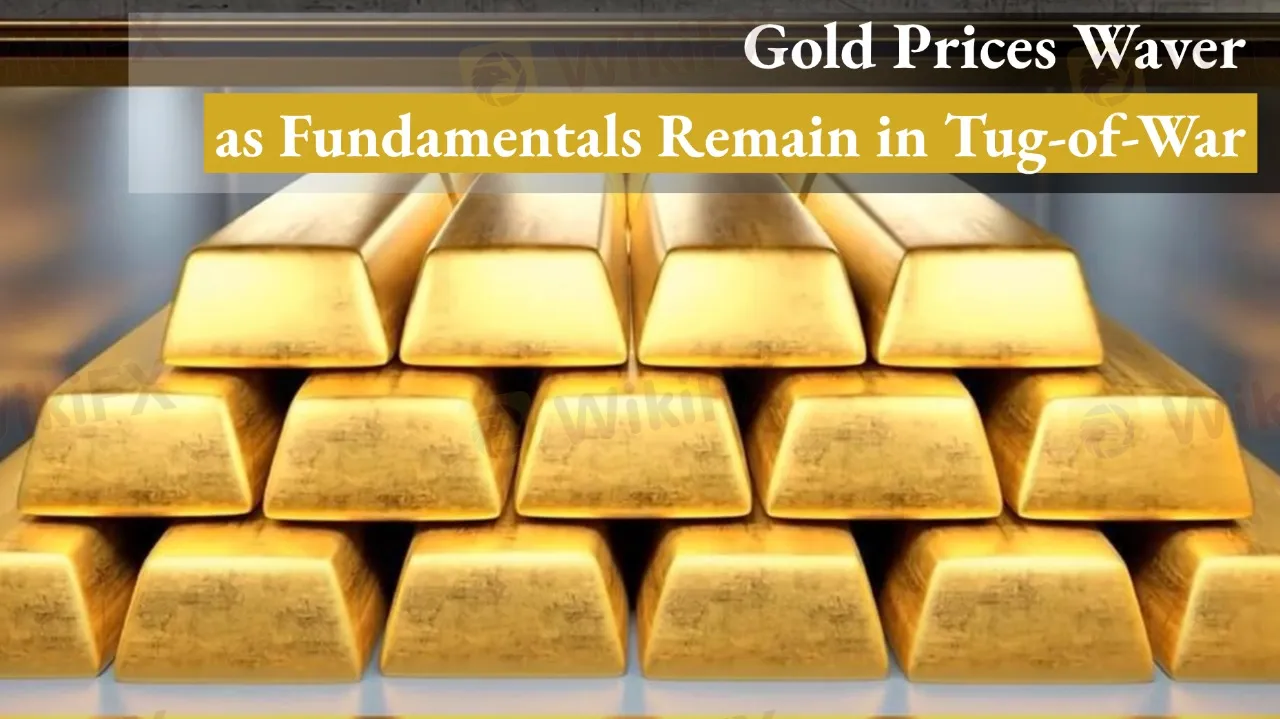简体中文
繁體中文
English
Pусский
日本語
ภาษาไทย
Tiếng Việt
Bahasa Indonesia
Español
हिन्दी
Filippiiniläinen
Français
Deutsch
Português
Türkçe
한국어
العربية
Gold Prices Waver as Fundamentals Remain in Tug-of-War
Abstract:Gold remains stuck in a sideways range, with $3,300 acting as a key technical pivot.

This week, the gold market continued to trade within a choppy and high-level consolidation pattern. On June 9, spot gold briefly dipped below the $3,300 mark before rebounding toward $3,328, supported by a weaker dollar and declining U.S. Treasury yields. However, as market expectations for rapid Fed rate cuts in 2024 continued to cool, golds upside momentum remained constrained. During the European session, the price largely moved sideways in a narrow range.
Technically, gold has entered a consolidation zone after pulling back from its yearly high of $3,499.83. Bollinger Bands have narrowed, signaling reduced volatility. Daily candlesticks show alternating small bullish and bearish candles, reflecting a balance of power between bulls and bears. The price continues to fluctuate around the middle Bollinger Band near $3,306.
Key short-term support is seen at $3,250, with major downside protection at $3,189. On the upside, resistance is around $3,380 — a break above could trigger a fresh upward leg. MACD indicators show the DIFF and DEA lines entangled near the zero axis, with histogram bars flipping direction repeatedly — no clear trend has emerged. RSI sits at 51.59, remaining neutral and signaling indecision. Overall, the technical structure suggests a lack of directional clarity, with the market entrenched in range-bound behavior.
Conflicting Drivers Weigh on Gold
The lack of sustained momentum in gold prices can be attributed to multiple conflicting macro factors that are effectively canceling each other out — a classic tug-of-war scenario in the fundamentals.
1. Fed Rate Cut Outlook Uncertain
The U.S. added 139,000 jobs in May, slightly above expectations, though Aprils figure was revised down to 147,000. The unemployment rate held steady at 4.2%, while average hourly earnings grew 3.9% year-on-year, slightly above forecasts. These figures point to continued resilience in the U.S. labor market but were not strong enough to shift Fed policy expectations significantly.
As a result, the prospect of near-term Fed rate cuts has diminished. With policymakers leaning toward maintaining higher rates for longer, the medium-term bullish thesis for gold — which thrives in lower-rate environments — has lost steam.
2. Dollar and Treasury Yields Create Mixed Signals
Despite concerns over the growing U.S. fiscal deficit, which typically weighs on the dollar, the greenback has shown resilience. Treasury yields have slipped, which normally supports gold, but the Feds hawkish bias provides underlying strength to the dollar, making gold rallies short-lived and prone to reversals.
3. Geopolitical Risks Offer Limited Support
Tensions in Ukraine and parts of the Middle East continue to simmer, which has provided intermittent safe-haven flows into gold. However, markets have become desensitized to geopolitical risks, and these events have failed to drive a sustained trend. Investor reactions to such developments remain relatively measured, limiting their impact on long-term gold pricing.
Uncertain Direction, Increased Volatility
In this market environment, gold investors are facing significant headwinds. With no clear directional trend and external variables in constant flux, executing effective strategies has become increasingly difficult.
1. Trendless Market, Shifting Narratives
Gold prices remain range-bound between $3,250 and $3,380. Technical signals are mixed, and traditional trend-following strategies have struggled to perform. Investors risk getting caught in “whipsaw” movements on both sides of the market.
2. Increased Sensitivity to Policy and Data
Each Fed statement or key macroeconomic data release now carries heightened impact, triggering volatile short-term moves. With monetary policy direction still uncertain, markets are reacting to even minor shifts in rate expectations, requiring fast responses and disciplined risk management.
3. Complicated Safe-Haven Logic, Lower Margin of Safety
Though gold is still viewed as a safe-haven asset, its effectiveness has diminished. The fading influence of geopolitical shocks and inconsistent ETF flows have added to investor hesitation. Retail traders, in particular, may find themselves chasing positions without institutional support.
For now, risk control, reduced position sizing, and a lowered expectation for returns may be the most prudent approach while awaiting a more decisive breakout.
How to Identify a Ranging Market and Adapt
In financial markets, ranging or sideways markets — like the one currently seen in gold — often present the biggest challenge for investors. Without a strong trend, both long and short positions become more vulnerable. So, how can one recognize such conditions and adjust their approach?
What is a Ranging Market?
A ranging market occurs when prices oscillate within a defined horizontal band, lacking sustained upward or downward momentum. The current $3,250–$3,380 gold range is a classic example. It often reflects indecision due to the absence of dominant fundamental drivers.
How to Identify a Ranging Market?
Flat Price Movement: Candlestick charts show alternating small bullish and bearish candles with limited price expansion.
Narrowing Bollinger Bands: Indicates lower volatility and the absence of directional conviction.
Neutral Indicators: MACD, RSI, and other oscillators hover around their midlines, producing inconsistent signals.
Balanced Macro Drivers: Rate outlook, economic data, and risk sentiment fail to deliver a unified narrative.
Strategies for Ranging Markets:
1. Trade the Range, Avoid Breakouts
Use defined support and resistance levels — for example, consider buying near $3,250 and selling near $3,380. Be cautious with breakouts; many turn out to be false. Always set stop-losses.
2. Scale Down Exposure
Smaller positions allow for greater flexibility and reduce the psychological impact of false signals.
3. Dont Predict, React
Instead of trying to guess when the breakout will come, respond to confirmed moves. If gold convincingly breaks $3,380 on strong volume, consider initiating a trend trade. If it breaks below $3,250, reevaluate bullish bias.
4. Be Patient for a Confirmed Breakout
Ranging markets inevitably end — often with a strong directional move. Watch for volume spikes, fundamental catalysts, or confirmed technical patterns before committing significant capital.
No Trend Yet, All Eyes on $3,300 Pivot
Gold remains caught in a fundamental and technical tug-of-war. While downside is supported by weaker yields and occasional safe-haven demand, a lack of clear drivers has kept price action range-bound. The $3,300 level remains a key battleground for bulls and bears.
In such uncertain environments, the best strategy may be to stay cautious, reduce exposure, and wait for a decisive signal — whether fundamental or technical — to set the stage for the next major move.

Disclaimer:
The views in this article only represent the author's personal views, and do not constitute investment advice on this platform. This platform does not guarantee the accuracy, completeness and timeliness of the information in the article, and will not be liable for any loss caused by the use of or reliance on the information in the article.
Read more

Voices of the Golden Insight Award Jury | Hawk Cheng, Director of Plotio Financial Group
The “WikiFX Golden Insight Award” is dedicated to uniting industry forces to jointly build a safe and robust forex ecosystem, driving industry innovation and sustainable development. Now it launches a brand-new interview series — “Voices of the Golden Insight Award Jury”. Through in-depth interviews with authoritative jury members, this series will explore the future landscape of the forex industry and the shared mission of industry elites in enhancing innovation, compliance, and sustainable development.

Polymarket Onboards First US Users Since 2022 Shutdown: Beta Relaunch Signals Major Comeback
Crypto-based prediction platform Polymarket has officially begun onboarding select U.S. users for real-money betting, marking its first return to the American market since a regulatory shutdown in 2022.

WikiEXPO Global Expert Interviews: Gustavo Antonio Montero: ESG in Finance
As WikiEXPO Dubai concludes successfully, we had the pleasure of interviewing MR. Gustavo, the Chairman and Founder of Carter Capital Management. (Sustainable Digital Assets Management) and Palmer Advisory and Consulting. Palmer is a global business that develops advanced fintech/digital technology solutions and works with Blockchain technologies.

Global Guide to Finding Forex IBs/Brokers — Share Your Pick and Win Big!
Dear forex enthusiasts, are you also troubled by these questions? “In India, can’t find a reliable IB? What should I do?” “With so many brokers, which one offers the lowest spreads and fastest withdrawals?” “Want to connect with local forex enthusiasts but don’t know where to start?” Now, leave these challenges to us! Share your experience and win exciting rewards!
WikiFX Broker
Latest News
Consob Targets Political Deepfake “Clone Sites” and Unlicensed Platforms in Latest Enforcement Round
WikiEXPO Global Expert Interviews: Gustavo Antonio Montero: ESG in Finance
2 Malaysians Arrested in $1 Million Gold Scam Impersonating Singapore Officials
Is FXPesa Regulated? Real User Reviews & Regulation Check
Fraud Mastermind Zhimin Qian Sentenced to 11 Years for $6.6 Billion Bitcoin Ponzi Scheme
Almahfaza Broker – 2025 Review: Safe or Scam?
Uniglobe Markets Review 2025: A Complete Guide to an Unregulated Broker
INZO Broker No Deposit Bonus: A 2025 Deep Dive into Its Offers and Risks
Exness Broker Expands in South Africa with Cape Town Hub
Global Guide to Finding Forex IBs/Brokers — Share Your Pick and Win Big!
Currency Calculator



